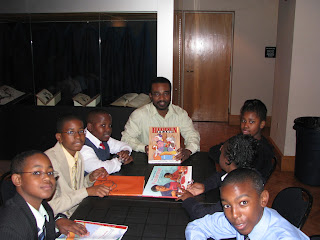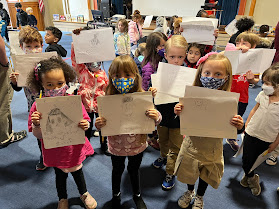I first started speaking at elementary schools in Iowa back in the early ‘90s, way before my first trade picture book published. At that time, I illustrated a lot of basal readers for educational publishing companies. My work soon got the attention of a local social service agency, who invited me to speak at elementary schools—whoa!?
Like a lot of writers and illustrators, I was an introvert. And I was shy, too (there's a difference). The idea of talking to anyone other than myself or my mom was strictly out of the question. I mean, what would I talk about? Honestly, I knew the answer. Kids love art, and a visiting artist would be inspiring for them. Still, I needed time to get over my fear of public speaking.
Fast forward thirty years later—I’m now way past my fear of speaking to large groups. In fact, believe it or not, I enjoy it. Today, I present at elementary schools all over the country—in person and virtually. For me, there’s nothing more delightful than when I’m sharing my experiences with young readers. I love the excitement in their eyes when they meet “the author.” I love their interesting and over-the-top questions. And I love their letters and drawings that often follow. Here are a few things I’ve learned along my school visit journey:
First and foremost, visiting elementary schools is not a must. I’ve met many authors and illustrators
who have no interest in presenting at schools, but somehow feel pressured to do so—for promotional reasons; or because their publishers asked them to; or because, they think, children’s authors are supposed to do so. But here’s the thing: don’t treat children like they’re a promotional opportunity. Visit schools out of a genuine love and caring for children. As authors and illustrators, we have this wonderful career because of the kids! So, if you’re going to visit schools, do so out of the spirit of love, teaching, edifying, and inspiring a lifetime appreciation of reading. Also, if kids really aren’t your thing (yes, I’ve met a few children's book authors who fall into that category), do kids a favor: Write books, but don’t visit schools.
Don’t be boring. I know, that sounds kind of simplistic, huh? But seriously, if I had a dime for every teacher or librarian who confided in me that most author visits they’d experienced were boring, I’d have quite a few dollars built up. Author visits are a day that children will carry with them for a lifetime, so make the day special. Now I don’t mean that you have to juggle flaming torches to get kid's attention, but you do need to think about and plan, and to find a way to engage them. Some kids already think that books are boring—I mean, books have to compete with TikTok, Netflix, and Minecraft. So, don't do a boring author visit. Keep in mind, learning to engage children isn't going to happen on the first few visits—being an engaging speaker is a learning process. Take a speaking course. Join Toastmasters. Show up (ask permission) at a school when a visiting author is in your area. How does that author engage an audience? Think about yourself as a child—how could a visiting author have grabbed your attention?
Make positive connections. As much as author visit day is about you sharing with students, it’s also a day for students to share with you. So make connections. The simplest way to make a connection is through a smile. No matter what kind of crazy my life is before entering a school, once I pass through the doors, I’m going to connect with everyone through a smile. I want everyone to feel welcome around me, I want to leave a positive impression. You never know what kinds of monsters a child might be dealing with. A simple smile, eye-to-eye contact with a high-five or a wave, goes a long way.
In addition, while I’m presenting, I try not to keep the focus only on myself. I want the students to tell me about themselves too. What are they really good at? What are their special talents? I keep the presentation interactive—an ebb and flow of author and students sharing with each other. Once they’ve shared their dreams and aspirations with the author, you’ve made a meaningful connection.
Personal gender pronouns. Okay, I’ll admit, I was slow to understand the pronoun conversation. I’m 58-years-old. For the majority of my life, “they” and "them" were plural pronouns that quickly earned a bad grade in English class, if you used them in the singular. Visiting schools turned me around, though. There's no worse feeling than referring to a child as “he” and then having them correct you—in front of the entire class—as, “I’m a she,” or vice versa. That happened a few times, and I felt awful. I want to be respectful of every child who crosses my path, so I learned. And I changed. During a Q&A at a virtual school visit recently, a child thanked me for identifying my pronouns on my profile picture, saying to me in front of the entire class: “You made me feel safe.” I want every child to feel safe and respected.
Don Tate is the award-winning author and/or illustrator of numerous picture book biographies, including PIGSKINS TO PAINTBRUSHES: THE STORY OF FOOTBALL PLAYING ARTIST EARNIE BARNES (Abrams, 2021) and SWISH! THE SLAM-DUNKING, ALLEY-OOPING, HARLEM GLOBETROTTERS (Little Brown, 2020). His WILLIAM STILL AND HIS FREEDOM STORIES: THE FATHER OF THE UNDERGROUND RAILROAD (Peachtree, 2020) was an SCBWI Golden Kite winner in the nonfiction category. Don is a founding host of the Brown Bookshelf, a blog dedicated to advocating for Black authors and illustrators writing for children. When Don isn’t writing, illustrating or visiting elementary schools, he enjoys working out, swimming, yoga, and anything sweet and chocolaty.





No comments:
Post a Comment